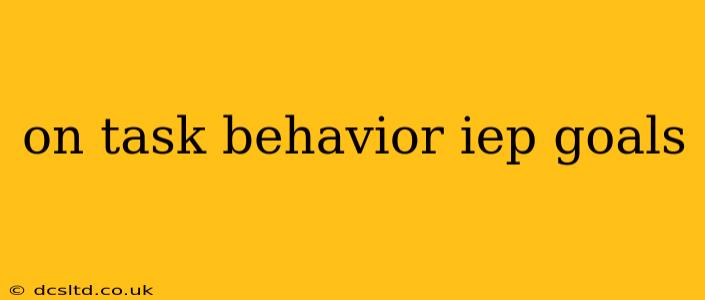On-task behavior is crucial for student success. An Individualized Education Program (IEP) often includes goals specifically targeting this area, aiming to improve a student's ability to focus and participate effectively in learning activities. This guide provides a comprehensive overview of on-task behavior IEP goals, addressing common questions and offering strategies for implementation.
What are On-Task Behavior IEP Goals?
On-task behavior IEP goals define specific, measurable, achievable, relevant, and time-bound (SMART) objectives focused on increasing a student's engagement in academic tasks. These goals address the underlying reasons for off-task behavior, whether it's due to inattention, impulsivity, difficulty with organization, or other factors. They aim to help students stay focused, participate actively in class, and complete assignments independently.
Examples of On-Task Behavior IEP Goals
Here are several examples of on-task behavior IEP goals, demonstrating different levels of complexity and approaches:
-
Goal 1 (Early Elementary): Given a 20-minute independent work period, [Student's Name] will remain on-task for at least 15 minutes, as measured by teacher observation, three out of five days per week for four consecutive weeks.
-
Goal 2 (Upper Elementary): During a 45-minute classroom lesson, [Student's Name] will demonstrate on-task behavior (actively participating in the lesson, completing assigned activities, and minimizing disruptive behaviors) for at least 40 minutes, as observed by the teacher, on four out of five days per week for eight consecutive weeks.
-
Goal 3 (Middle/High School): Given a self-directed project lasting one week, [Student's Name] will stay on-task for a minimum of 75% of the allocated work time, self-monitoring progress using a time log and seeking assistance when needed, for three consecutive projects.
-
Goal 4 (Addressing Specific Needs): In a structured learning environment using visual supports and frequent check-ins, [Student's Name] will independently work on assigned tasks for 10-minute intervals, maintaining on-task behavior for at least 8 minutes during each interval, four out of five trials per week for six consecutive weeks.
How are On-Task Behavior IEP Goals Measured?
Measurement is vital for tracking progress towards on-task behavior goals. Common methods include:
- Teacher Observation: The teacher directly observes the student's behavior during specific activities. Using a checklist or rating scale ensures consistency.
- Data Collection Sheets: These sheets track frequency, duration, and intensity of on-task and off-task behaviors.
- Self-Monitoring: Older students can participate in self-monitoring by using timers, checklists, or daily logs to record their on-task time.
- Technology-Based Systems: Apps and software can automatically track student engagement with specific tasks.
What Strategies are Used to Improve On-Task Behavior?
Effective strategies often employed in IEPs to improve on-task behavior include:
- Positive Reinforcement: Rewarding on-task behavior with praise, privileges, or tangible rewards.
- Visual Supports: Using visual timers, schedules, or task lists to help students organize their work and track progress.
- Environmental Modifications: Adjusting the classroom seating arrangement or creating a quieter workspace to minimize distractions.
- Behavioral Interventions: Implementing strategies like functional behavioral assessment (FBA) and positive behavioral interventions and supports (PBIS) to address underlying causes of off-task behavior.
- Instructional Modifications: Adapting teaching methods to better suit the student's learning style and needs.
How Frequent Should Check-Ins and Progress Monitoring Be?
Progress toward on-task behavior goals should be monitored regularly, ideally at least weekly or bi-weekly. More frequent checks might be necessary initially or if the student is struggling. Regular feedback and adjustments to the intervention plan are key to achieving successful outcomes.
What if My Child Isn't Meeting Their On-Task Behavior Goals?
If a student isn't meeting their on-task behavior goals, it's crucial to revisit the IEP. This might involve:
- Reviewing the Goal: Is the goal appropriately challenging but still achievable?
- Adjusting Strategies: Are the current interventions effective? Are new strategies needed?
- Re-evaluating Underlying Issues: Are there other factors (medical, emotional, etc.) impacting the student's ability to stay on-task?
On-task behavior IEP goals require a collaborative effort between educators, parents, and the student. By understanding the goals, implementing effective strategies, and regularly monitoring progress, students can develop essential focus and self-management skills to reach their full academic potential.
